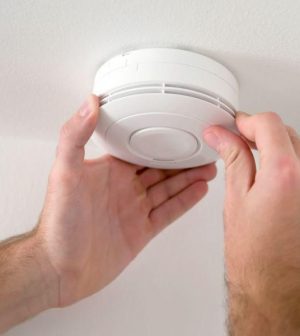- Navigating Your Midlife Crisis: Embracing New Possibilities
- City Raccoons Showing Signs of Domestication
- Mapping the Exposome: Science Broadens Focus to Environmental Disease Triggers
- One Week Less on Social Media Linked to Better Mental Health
- Your Brain Changes in Stages as You Age, Study Finds
- Some Suicide Victims Show No Typical Warning Signs, Study Finds
- ByHeart Formula Faces Lawsuits After Babies Sickened With Botulism
- Switch to Vegan Diet Could Cut Your Greenhouse Gas Emissions in Half
- Regular Bedtime Does Wonders for Blood Pressure
- Dining Alone Could Mean Worse Nutrition for Seniors
‘Spring Forward’ This Weekend By Checking Your Home Smoke Alarms

When you turn your clocks forward to Daylight Saving Time this weekend, take a few minutes to make your home safer.
Change the batteries in your smoke and carbon monoxide (CO) alarms, the U.S. Consumer Product Safety Commission (CPSC) suggests. Unless these devices have sealed 10-year batteries, they require fresh batteries every year. It’s also important to test them every month to make sure they’re working properly.
If you have a plug-in type CO alarm, this is also a good time to be sure that it has battery backup.
“Smoke and carbon monoxide alarms save lives,” said Robert Adler, acting chairman of the CPSC. “Working alarms with fresh batteries buy your family valuable time to escape from a fire or a lethal buildup of carbon monoxide in your home.”
CO alarms should be placed on every level of your home and outside sleeping areas. Place smoke alarms on every level of your home, inside each bedroom and outside sleeping areas.
If a smoke or CO alarm sounds, go to a safe location outside your home and call the fire department.
Each year, about 400 Americans die of carbon monoxide poisoning, according to the U.S. Centers for Disease Control and Prevention (CDC).
Carbon monoxide is known as the silent killer because you can’t see it or smell it. It comes from number of sources, including furnaces and portable generators.
Prevent fires by having your fuel-burning appliances such as your furnace and fireplace inspected by a professional each year. Keep space heaters away from curtains, beds and anything combustible. If you have fire sprinklers, make sure their water supply is open.
Never operate a portable generator inside a home, garage, basement, crawlspace, shed or on a porch close to the house.
It’s also important to create a fire escape plan. There should be two ways out from each room, usually a door and a window, and a clear path outside from each exit. Everyone in the home should know the plan, and it should be practiced twice a year.
More information
The U.S. Fire Administration has more on carbon monoxide safety.
SOURCE: U.S. Consumer Product Safety Commission, news release, March 10, 2021
Source: HealthDay
Copyright © 2025 HealthDay. All rights reserved.










